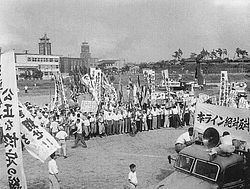Hangul 이승만 라인 Revised Romanization I Seungman Rain | Hanja 李承晚線 McCune–Reischauer Yi Sŭngman Rain | |
 | ||
The Syngman Rhee Line (Hanja:李承晩線, Hangul: 이승만 라인) refers to a boundary line established by South Korean President Syngman Rhee in his "Peace Line" (평화선, Hanja:平和線) declaration of January 18, 1952, which included the Liancourt Rocks (Dokdo/Takeshima) in Korean territory.
Contents
Rhee stated that the purpose of the line was to protect Korea's marine resources around the Sea of Japan; therefore it banned non-Korean fishing boats from inside the territory, and Liancourt Rocks in particular.
South Korea had demanded that the MacArthur line established after World War II continue to be enforced, though on August 10, 1951, the United States sent Korean Ambassador Yang You Chan the Rusk documents, stating that the official policy of the United States was that the MacArthur line would be abolished by the Treaty of San Francisco. The treaty was signed on September 8 of the same year, about a month after the documents were sent, and was to come into effect on April 28, 1952. In response, the South Korean government declared the Syngman Rhee Line three months before this date, when the extinction of the MacArthur line and the return of sovereignty to Japan were meant to be established.
According to the Report of Van Fleet Mission to Far East made in 1954, the U.S. government maintained that the one-sided declaration of the Syngman Rhee Line was illegal under international law.
The fishing boats - which were mostly Japanese - that violated the boundary line were seized by South Korea. Japanese records claim that such ships were often fired upon. The Japanese government protested the seizures and unilateral declaration strongly, but the abolition of the line had to wait even for the approval of the Japan-Korea Fishery Agreement in 1965. By the time an agreement was reached, 3929 Japanese people were arrested, of whom 44 were killed, and 328 Japanese ships were seized.
According to the demand of the South Korea Government, Japanese Government released 472 Korean criminals in Japan who had been imprisoned as a serious criminal or a habitual criminal and granted them the special permission of residence in exchange for the restoration of Japanese detainees. Korea refused an enforced repatriation to Korea of illegal immigrants, serious criminals and political offenses.
Solving the problem
Solving the problem required many years. Obstacles to its settlement included the fact that there were no formal diplomatic relations between Japan and South Korea at the time, that normalization talks were complicated by various compensation claims, and the refusal of the United States to intervene on the issue, regarding it as bilateral.
